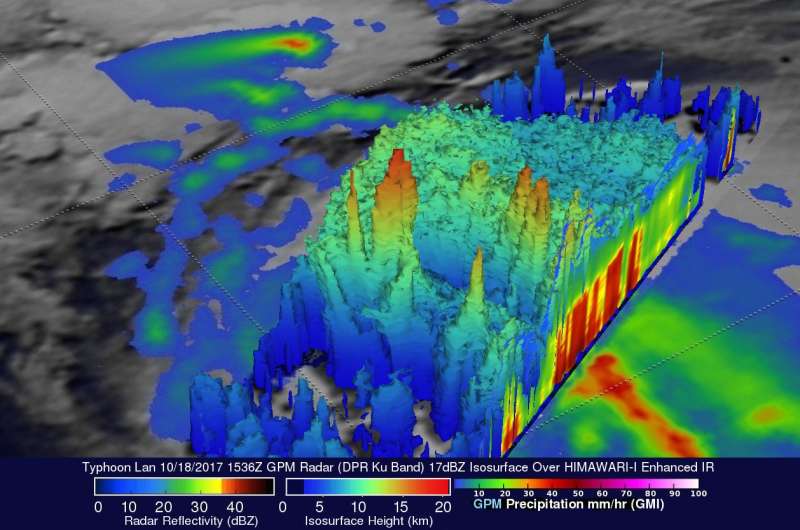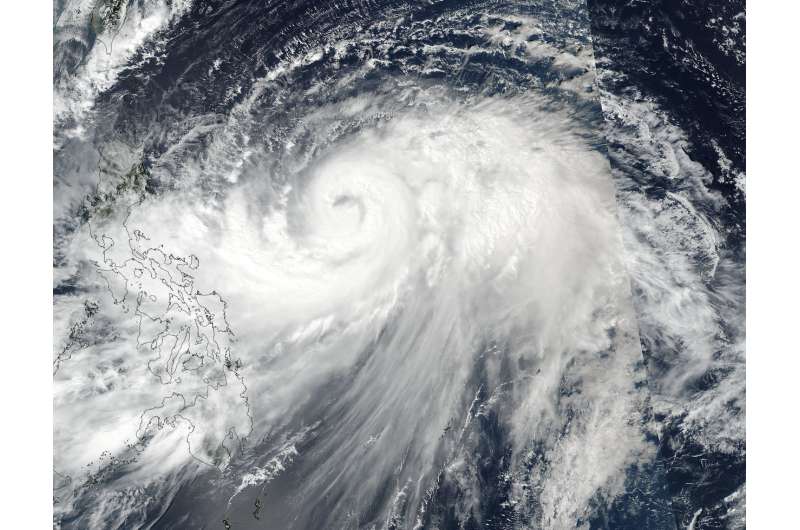NASA sees intensifying Typhoon Lan stretch high in the troposphere

NASA's Global Precipitation Measurement mission or GPM satellite provided 3-D data that showed intensifying Typhoon Lan had powerful thunderstorms stretching high into the troposphere. NASA-NOAA's Suomi NPP satellite provided a visible image Typhoon Lan that showed the well-developed circulation.
Tropical depression twenty five formed in the western Pacific Ocean west of Yap on Oct. 15. After that the intensifying tropical cyclone moved into the Philippine Sea. Tropical Storm Lan recently moved toward the north and was upgraded to Typhoon Lan.
On Oct. 19, maximum sustained wind speeds reached 75 knots (~86 mph). That made Lan a category one on the Saffir-Simpson hurricane wind scale. Extremely warm ocean waters (30-31 degrees Celsius) along Lan's path are providing fuel for further intensification.
On Oct. 19 at 12:48 a.m. EDT (0448 UTC) the NASA-NOAA's Suomi NPP provided a visible image of Typhoon Lan east of the Philippines. The image showed powerful, thick bands of thunderstorms spiraling into the center. The eye was obscured by high clouds.
Earlier, on Oct. 18, 2017 at 1135 a.m. EDT (1535 UTC) the core satellite of the Global Precipitation Measurement (GPM) mission passed almost directly above Typhoon Lan's eye and analyzed the rainfall and measured the cloud heights.
GPM's Microwave Imager (GMI) and Dual-Frequency Precipitation Radar (DPR) instruments collected data that were used in this examination of Typhoon Lan's rainfall.
GPM's DPR revealed that extremely heavy rainfall was located in the southeastern side of the typhoon's eye wall. Powerful storms there were dropping rain at a rate of greater than 227 mm (8.9 inches) per hour. GPM's GMI additionally showed that typhoon Lan was producing heavy rain over a large area with a large well defined feeder band wrapping into the southwestern side of the typhoon.
A 3-D cross-section view of Typhoon Lan's precipitation was constructed at NASA's Goddard Space Flight Center in Greenbelt, Md. using data collected by the GPM satellite's radar (DPR Ku Band). Of particular interest were extremely tall thunderstorm towers in the southeastern side of Typhoon Lan's eye wall. Some of these very tall towers were measured by GPM's radar (DPR Ku Band) reaching amazing altitudes above 18.6 km (11.5 miles). The heat released by condensation within these tall thunderstorms provided fuel to aid in Typhoon Lan's intensification.
GPM is a joint mission between NASA and the Japanese space agency JAXA.
On Oct. 19 at 11 a.m. EDT (1500 UTC), Typhoon Lan's maximum sustained winds were near 75 knots. It was located near 16.9 degrees north latitude and 130.0 degrees east longitude. Lan was about 589 miles south-southeast of Kadena Air Base, Okinawa, Japan and moving north at 6 knots (7 mph/11 kph). Lan is a large storm with tropical storm-force winds extending between 210 to 365 miles from the center. That makes Lan's diameter between 420 miles to 730 miles.
The Joint Typhoon Warning Center (JTWC) predicts that typhoon Lan will continue to intensify as it moves toward higher latitudes and is expected to become a powerful typhoon with winds of 110 knots (~127 mph) in a couple days.

Provided by NASA's Goddard Space Flight Center





















